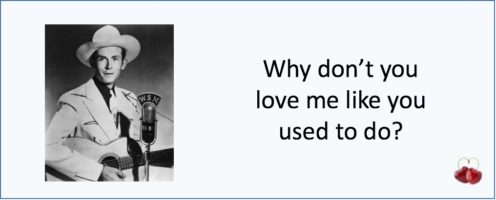36 – Earworms
One of the teacher-trainers that I most admire is Adrian Underhill. I like the way he encourages learners and teacher trainees to explore. He encourages people to mouth (maʊð) a full range of sounds, not simply the ‘correct’ ones – and he encourages people to dance around, using their whole body to get the feel of sounds.
And I think those of us who teach decoding in our listening classes have something to learn from his methods – and this brings me to the notion of earworms. This is an idea that I first heard about in a presentation by Annie McDonald of which you can find more details here.
An earworm is an annoying extract from a song that keeps on re-playing in your head long after you have heard the song. For me, this song by Hank Williams creates an ear worm: ‘Why don’t you love me like you used to do? How come you treat me like a worn-out shoe? My hair’s still curly, and my eyes are still blue, why don’t you love me like you used to do?’
I wonder (I’ve never tried it, so I don’t know if it will work) if we could attempt to create, and plant earworm-like stretches of speech in our learners heads, and encourage them to cherish them (rather than banish them) and repeat them over and over as they walk, jog, run, or exercise in the gym.
I’ve created one, which you can hear below, which uses the words ‘where there were’ (these words also feature on this page) as part of a follow-up to a Jungle Listening lesson (no. 10 of a pilot publication you can find here).
The idea of this particular ear worm is to provide as many different soundshapes of the word cluster ‘where there were’ as it was possible for me to do (yep, the voice is me).
The idea is to explore a sample of the range of ways in which these words might be said and heard in a world (the real world) where people have accents and the words can be said in an infinite number of ways which cannot be constrained by rules. An earworm such as this is a form of vocal gymnastics which might go some way towards fulfilling an important requirement of any decoding work identified by John Field:
‘… to encounter the same words in a wide range of contexts and voices … [by assembling] … examples of the same groups of words uttered in different circumstances and at different speeds by a number of different speakers’ (Field, 2008: 166)
My hope is, that by creating earworms, we can produce the effect of hearing words in different voices, accents, and speeds that learners can carry around in their heads, and repeat. The desired effect would be to get them accustomed to handling real-like English at fast speeds, expanding the capacity of their short term memory to hold stretches of the sound substance of English in their minds.


